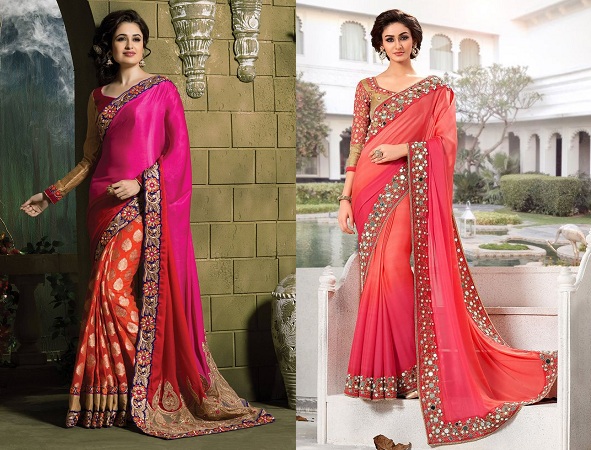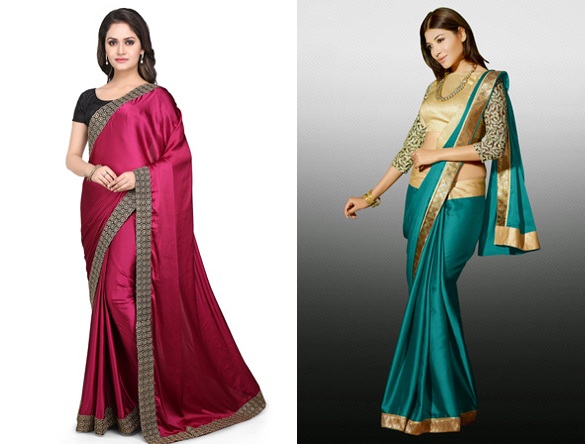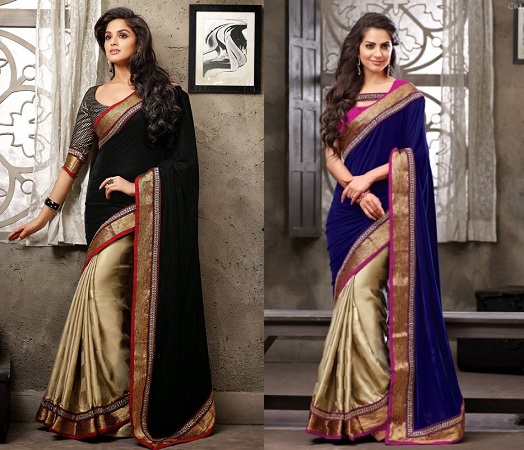
Satin sarees – Exuding luxury !
As they say, every woman who loves sarees must have a satin saree in her wardrobe. Satin – the weave is unmistakably associated with “luxury”. The luxurious feel is directly attributed to the glossy texture of these sarees. The fabric is characterized by a large number of “floats”. The missed interfacing where the warp yarn overlaps the weft in weft-faced satin are called the floats. Fibers that have fewer tucks than satin don’t look so luxurious or glossy since the light falling on them gets scattered. Women just love satin just for its sheer luster. It will definitely be interesting to find out more about its history.
A sneak peek into the history of Satin: A favorite since centuries
Let us clarify from the very beginning that satin is not really strictly a “modern” favorite but a weave which has been cherished for centuries. The use of this particular material has not really been restricted to clothing. We have witnessed the liberal use of satin in bedding items, ballet shoes, wedding gowns and even athlete uniforms. Satin has found such wide acceptance primarily because of its luster.
Satin made for a fairly prevalent fabric during the Middle Ages and was derived from silk. Since it was expensive only the affluent families could afford it. It originated in a Chinese port city called Quanzou, alternately known as Zayton by the Arabs. The place emerged as a prominent shipping port of silk during the late Middle Ages.
With the passage of time, the popularity of the weave spread across Europe (especially in the 12th century). Actually, in the 12th century it was mainly popular in Italy but only during the 14th century did it become famous throughout Europe. There was a time when the royal robes were only made of satin. Till to this day, satin is essentially known as a “rich” fabric. Chinese artists were primarily responsible for creating satin used in robes.
The popular weave did become more accessible to the not-so-wealthy population but it happened only after the Industrial Revolution.
The fabric also made for one of the most popular items traded between China, Western Europe and Arabia. Satin, it can be said, definitely made way for better trading relations between these countries.

How are satin sarees made?
If you call yourself a fan of satin sarees you should know that it is the name of the weave but not the raw material itself. The process of twill weaving is employed to make satin. The low-twist yarn consisting of the weft threads lends satin its quintessential smoothness. A single length-wise yarn covers these weft threads or four horizontal yarns. It can be created from polyester, cotton and wool. Ladies often confuse between satin and silk sarees. However, there’s a very easy way to differentiate between these two. Satin’s sheen outdoes that of silk’s by a huge margin. A part of the fabric (surface) is conspicuously lustrous while the other part is matte or dull. Don’t forget that tailors have a tough time dealing with satin weaves since they keep slipping away.
Satin sarees: Getting the right look
Since satin is quintessentially associated with opulence (we have already told you how it had been a favorite of the Royals), it is primarily worn at ceremonies like weddings, engagements, parties and festivals.
One of the most beautiful attributes of satin drapes is that it can be worn by women of all body types. For instance, a stiff, heavily embroidered cotton saree may not be particularly suitable for women who are overweight. However, a free-flowing satin saree will not really pose a problem for them. Team them up with the right accessories and blouses and it will not really be difficult for you to turn heads at the next social do.
Satin makes for the most popular choice as far as elegant dressing is concerned. It does not matter whether you are attending a wedding or club party—if it’s the fabric of the saree (to be worn) that you are confused about, satin can always be a safe choice.

What you need to find out about its maintenance
Please remember that satin is a very delicate material which needs proper maintenance. If you have a satin silk saree to take care of, it’s best to dry-clean it. Polyester satin sarees should be cleaned only with mild detergent. Make sure you are keeping them properly inside the almirah so as to avoid creases. Refrain from wringing them dry as well.
If you are careful enough not to expose your saree to excessive use, then you can you can expect it to have a long shelf-life. The weave results in really tender fabrics that offer desirable services if not exposed to hard wear. Satin does look greasy after continuous wear. However, one of the best attributes of this weave is that it doesn’t let dirt settle on it – it’s so slippery!
Other properties of Satin sarees
Like any other fiber or weaves, Satin is available in plain and mixed hues as well as in prints. Though it has already been said that this particular drape complies with needs of all body types, you should keep the cardinal rules of draping sarees in mind while choosing pieces for yourself. For instance, if you are short, then go for thinner borders instead of block motifs. The thin borders render an illusion of height thereby making you look taller than what you actually are. Blocks, on the others hand, will do no such thing for you.
On the other hand, if you are already tall, then sporting sarees with thin borders will actually make you look like a pillar. You can always afford to take the attention a tad away from your height by opting for blocks or solid designs on your saree.

Choosing the right store
There are several online stores offering gorgeous satin sarees. Make sure you’re settling for the services of reputed stores, known for offering quality sarees within a competitive price range. Spend considerable time on background research of the stores.





